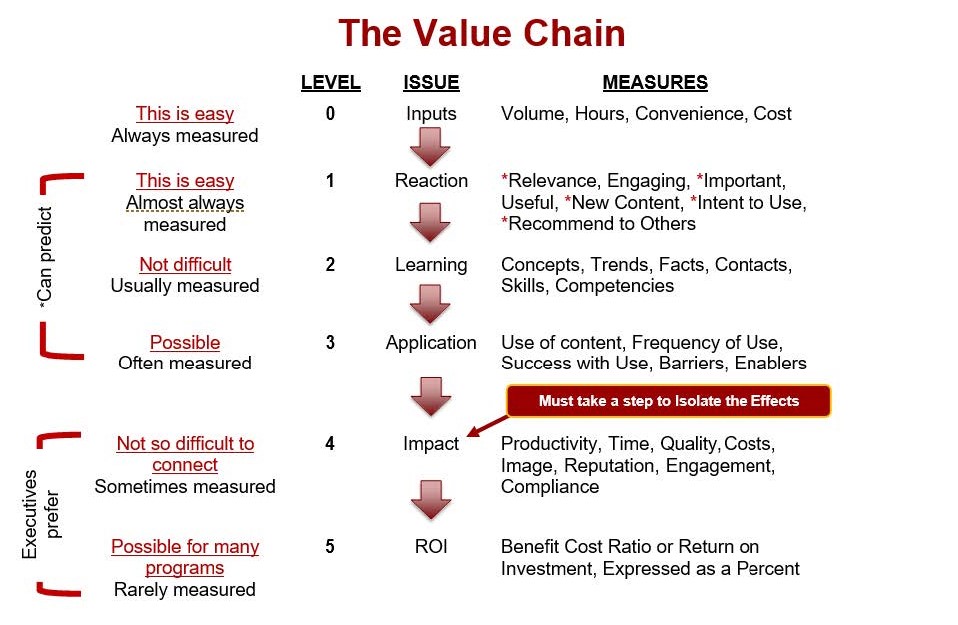Your cart is currently empty!
The Dilemma of Leadership Development
In the field of leadership development, a dilemma exists with many executives, who often support and fund leadership development programs. These executives know that great leaders are needed to drive results now more than ever, and for the most part, they must develop those leaders internally. Leadership development is necessary, and it usually ranks at the top of issues facing executives, according to the Conference Board.
At the same time, the leadership development providers are content with showing executives that they have changed leader behavior. The 360° feedback process has been dominant in demonstrating the value of leadership development. But this is only behavior change. The same providers are reluctant to connect behavior change to meaningful and important business measures. Yet, when used properly, leader behavior will drive all types of important impact measures in an organization. That’s what executives want to see. It’s not leader behavior they want; it’s the results of the leader behavior that is desired.
A recent article in the MIT Sloan Management Review (Winter 2024) highlighted this problem.1 In this article, “Leadership Development Is Failing Us. Here’s How to Fix It,” the authors suggest that leadership development should drive impact, but does not, and offered their prescription for change to the consumers of leadership development, the HR executive.
What Happens
In some situations, executives request leadership development because they see the need for leaders to deliver important results. They need great leadership to make it happen. Sometimes, HR or L&D executives suggest that leadership development is needed to meet future challenges. The programs start with leader behavior in mind. The perceived end of the process is to make sure the leader behaviors are in place. This is often reported to executives, showing a profile of success in the 360° feedback, or other leadership assessment documents, proclaiming that behaviors are in place. This approach leads to frustration for executives, particularly those who funded the program. So, how did it help the organization? What impact did it have? Is this a good investment for us? Those questions often are ignored by the leadership development providers, and in some situations, with devastating consequences. For example, a front-page story in a Sunday newspaper in London proclaimed that, “Scotland Yard Wasting £10M on Leadership Training.”2
An analysis of the Scotland Yard situation clearly indicates that the focus and end goal was to have behaviors, not attempting to connect the program to major key performance indicators (KPIs) in the police department. It contained intensive in-person training, personality assessments, coaches, and 360o feedback. This citizen funded program, which involved 10,000 leaders at the sergeant level and above, occurred at a time when crimes were increasing and at all-time highs, and solving crime was at an all-time low. From the program funder’s perspective (citizens), an endeavor so expensive and involving so many people should be connected to important KPIs, such as crime prevention and crimes solved. But the program wasn’t connected to those measures. When a program isn’t connected to KPIs, it may have little impact on those measures.
Leadership Development Can Be Evaluated at the Impact and ROI Levels
It’s helpful to think about leadership development success in a value chain, as shown in Figure 1. This chain is a logical flow of data that occurs in any type of program or project. It is particularly relevant to leadership development. The input is the people involved in the program, the time they are involved, and the cost and convenience of their involvement in the program. The outcomes are at five levels:
Level 1, Reaction, ensures that participants involved in a leadership development program see that the program is relevant to their situation, important to them, something they would recommend to others, and are committed to making it a success. These are four powerful reactions that often serve as predictors of behavior change.
Level 2, Learning, is the classic acquisition or enhancement of knowledge, skills, and competencies, making sure the participants can actually do what is desired. Skill practices, role-plays, simulations, and self-assessments often validate that learning has been achieved. Without learning, a program will not be successful.
Level 3, Application, involves the use of the leader behavior, applying what they’ve learned. This is often measured by the extent, frequency, and success with use of the desired competencies. Without application, there is no impact. At this point, barriers and enablers to the use of the behaviors are captured.
Level 4, Impact, is the consequences of the behavior change. These are usually measures in the system and often measure productivity, sales, and project completion rates—key impacts that reflect the work of the organization. Impact also includes quality measures such as errors, waste, employee turnover, absenteeism, accidents, incidents, and rework that often occur. It can also involve time for tasks, procedures, and deliveries and softer measures, such as teamwork, engagement, collaboration, and stress. These measures attract executive attention and need to be connected to the leadership development program. Leader behavior, without the impact, is just being busy. Without impact, the ROI is very negative.
A key point at this level is to sort out the effects of the leadership development program from other influences. This can always be done, and it is a critical standard and important step in the ROI Methodology. This is the proof that the program made a difference. For a book chapter describing the various methods to isolate the impact of the program, please contact us.
Level 5, Return on Investment (ROI), answers the question, Is it worth it? ROI shows the monetary benefits delivered compared to the cost of the program. This ultimate accountability is the level of evaluation that should be considered for programs that are very expensive, important, strategic, and attract the executive’s attention for this level of accountability.
There you have it, the framework of the ROI Methodology that has become the most used evaluation system in the world.
Figure 1. The Value Chain

What Executives Prefer
In our work at ROI Institute, we have the opportunity and pleasure of working with top executives of major organizations worldwide. As you can expect, executives prefer to have leader behavior connected to impact, which is their No. 1 measure and ROI, their No. 2 measure, and we have known this for a long time.3 Impact and ROI is the world they live in. Yes, they know that the new behavior is necessary and often have input into the behaviors they would like to see. When it comes to measuring success, they want to see how the program connects to the organization and the value the new behavior delivers.
Why Should You Measure Now?
Measuring the success of leadership development is a key issue. Why measure now—particularly if there is a prospect that your program may not deliver the desired results? There are four reasons why you should measure now:
- Being Proactive Places You in a Good Position. If you wait until a program is completed and have the request from the executives who ask, “How did this help our organization? What was the impact?” Three things will happen. This places you in a defensive posture, defending the program you just implemented. You have a short timeline to deliver results—too short to probably make it work. And ROI is now on the executive’s agenda. You want to keep ROI on your agenda. Being proactive means you raise this issue, “Let’s see how this is connected to the organization. If it’s not driving impact, we will make adjustments to make sure it does.” You are in a much better position by taking the proactive approach in evaluating to impact and ROI. It would almost never result in the cancellation of a program because you are proactively trying to make sure it connects to the business.
- Lack of Positive Results is an Opportunity. If a program is not delivering the impact results, it is usually not the program’s content (e.g., behaviors) that is the problem, but it is perhaps that the behavior is not used or supported. Something is getting in the way of making this successful. This level of evaluation uncovers the barriers to success. It also reveals what caused the successes that you are delivering. These barriers and enablers are important influences in the program’s success.
- Process improvement is the key. The key issue is to make programs better. If it’s not working, make things better. If it is successful, make it even more successful. This relentless focus on process improvement optimizes the return on investment in this important resource. This helps you to secure future funding.
- Any Model Will Work? This is your chance to have your leadership model stand out from the others. A vice president of a large U.S. technology company told us recently that “It doesn’t matter which model we are using. It’s how we support it to make it work.” He suggested that almost any model will work, and that is probably true. That might sound unkind because there are so many great leadership development models now and probably too many leadership development books. The point is that almost any of these programs will be successful if they are implemented to the right audience and supported and nurtured in the organization. This level of evaluation can set your leadership development model apart from the others.
The Ideal Situation
To avoid the possibility of disappointing results, design the program to deliver the desired results and make sure that everyone involved is helping to deliver the needed success. This involves a series of steps in the ROI Methodology shown in Figure 2.
- Start with why.
It is important to start with the end in mind, the impact of the new behavior. Sometimes the end is clear, such as we have a retention problem, and the leadership program is implemented to address this issue. But, in many situations, it’s more than just retention. It could be any of the impact measures. One easy way to connect is to have each person attending the program identify two impact measures they want to improve, but only if they can improve them with their team using the competencies gained from the program. This is a simple yet powerful mindset change. It is communicating to participants that this program will help you improve your problems or important opportunities. It becomes their program now. The leader behavior is just the means to get there, and participants are more committed to making it work because they are addressing something they want to improve.
- Make sure it is the right solution.
Sometimes you are given a problem and you have the opportunity to conduct some analysis to ensure the leadership development solution is the proper one. At other times, you are provided a solution to implement. When this is the case, a simple way to make sure it’s the right solution is presented in step 1. Basically, participants attending a leadership development program identify two impact measures or KPIs they want to improve. Ask them if they can improve the KPIs using these planned competencies with their team. They are saying they think this is the right solution. That may be all you need to do to make sure you have the right solution. This would have been appropriate in the Scotland Yard situation.
- Expect success.
Three things occur with this step. First, everyone involved in the project realizes success doesn’t occur until the impacts are achieved. Second, to get there, objectives are set for reaction, learning, application, and impact. Third, provide these objectives to every member of the team—the designers, developers, implementers, owners, facilitators, participants, and the managers of participants. Together, as a team, they work to ensure that success is delivered at the impact level. They will use tools, templates, reinforcements, suggestions, encouragements, and anything possible to make sure it gets there.
- Follow the process.
The first three steps prepare the program for success. Following a process of collecting, analyzing, and reporting data, detailed in the 12-step process in the ROI Methodology, ensures that impact results are delivered. At this point, you won’t have a problem with having disappointing impact measures because they are the reason for implementing the program. You can collect the data using a variety of different types of data collection methods, and you can analyze them using the tools of the ROI Methodology.
Figure 2. The ROI Methodology

Our most recent book, Proving the Value of Leadership Development: Case Studies from Top Leadership Development Programs, contains examples of how this is being done with the ROI Methodology. If you would contact us directly, we can share case studies to show you examples.
So there you have it. It’s a challenge that leadership development providers must address. It’s not that difficult to show the impact and ROI of major programs. Literally hundreds of organizations are doing this now. We have published four books with different publishers on the value of leadership development, with case studies, and more will be published. We aim to show that evaluating leadership development at this level is possible and is needed. Let us know if we can help.
Written By:
Patti P. Phillips, Ph.D., and Jack J. Phillips, Ph.D.
References:
- Leroy, Hannes, Moran Anisman-Razin, and Jim Detert. “Leadership Development Is Failing Us. Here’s How to Fix It,” MIT Sloan Management Review, Winter 2024.
- Dixon. “Scotland Yard ‘wasting’ £10M on leadership training.” The Sunday Telegraph. June 3, 2018. Pg. 1 -2.
- Phillips, Jack J. and Patti P. Phillips. Measuring for Success: What CEOs Really Want from Their Learning Investments. Alexandria VA: ASTD Press 2010. Pg. 261
DOI: http://dx.doi.org/10.1108/SHR-01-2024-0006
This article was originally published in Strategic HR Review on March 11, 2024.


























